Never miss another geomagnetic storm. Sign up for Space Weather Alerts and you'll receive a text message when magnetic storms erupt. Aurora tour guides and professional astronomers use this service. You can, too! | | |
GEOMAGNETIC STORM WATCH: Minor G1-class geomagnetic storms are possible on Jan. 5th as Earth passes through the wake of a CME that struck our planet yesterday. Arctic sky watchers should remain alert for auroras. Aurora alerts: SMS Text.
FARSIDE SUNSPOT EMERGES: As expected, a large sunspot and complex sunspot group is emerging over the sun's southeastern limb. Current images from NASA's Solar Dynamics Observatory reveal a primary dark core approximately 3 times wider than Earth:
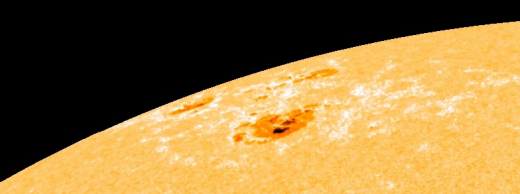
This is the same sunspot group that produced a significant farside explosion on Jan. 3rd. No one knows exactly how intense that explosion was, but circumstantial evidence suggests it was X-class.
Now that the active region is turning toward Earth, our planet could be in the line of fire for the next blast--*if* there is a next blast. Solar Cycle 25 is notorious for producing active regions that explode on the farside, then quiet down when they turn to face Earth. Time will tell if a geoeffective flare is in the offing.
Meanwhile, amateur astronomers are targeting the behemoth using backyard solar telescopes. Philippe Tosi sends this picture from Nîmes, France:
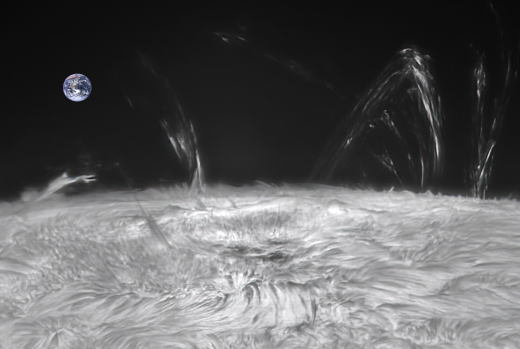
Tosi used an H-alpha filter tuned to the red glow of solar hydrogen. It reveals considerable turmoil surrounding the sunspot's primary core. Monitoring is encouraged .Solar flare alerts: SMS Text.
Realtime Space Weather Photo Gallery
Free: Spaceweather.com Newsletter
COMET ZTF UPDATE: One week from today, Jan. 12th, Comet ZTF (C/2022 E3) makes its closest approach to the sun (1.11 AU). Puffed up with solar heat, it will then head toward Earth for an even closer encounter (0.28 AU) on Feb. 1st. Here's what it looks like right now, photographed by Michael Jaeger of Jauerling, Austria:
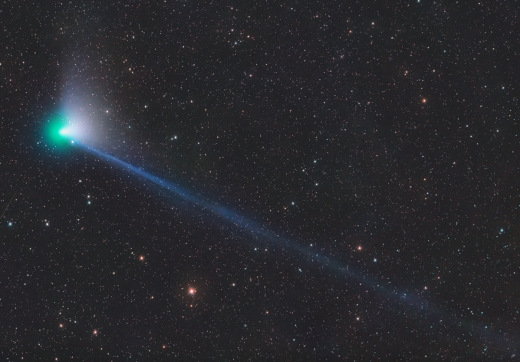
The comet has a bright green atmosphere, a fan-shaped tail of dust, and a gaseous blue streamer sculpted by solar wind into a narrow plume more than 3 degrees long. Experienced observers say it is about as bright as a 7th magnitude star--invisible to the naked eye, but an easy target for backyard telescopes.
To find Comet ZTF, wake up before sunrise and look east for the constellation Corona Borealis. It's right there.
Realtime Comet Photo Gallery
Free: Spaceweather.com Newsletter
A BLACK PEARL IN THE STRATOSPHERE: It came from Tahiti--and now it's been to the edge of space. This genuine Black Tahitian South Sea Cultured Pearl flew to the stratosphere onboard an Earth to Sky Calculus cosmic ray balloon, soaring more than 100,000 feet above the Sierra Nevada mountains of central California:
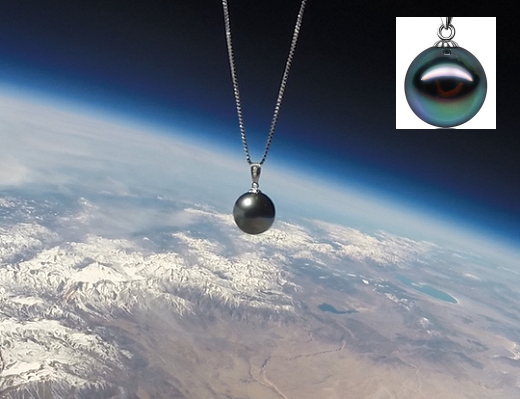
You can have it for $229.95. The students are selling exotic space pearls to fund their cosmic ray monitoring program. Measuring 10 mm in diameter, the pearl has an 18K white gold clasp and is suspended from a matching 925 Sterling Silver chain. Each pearl comes with a greeting card showing the pendant in flight and telling the story of its journey to the edge of space.
Far Out Gifts: Earth to Sky Store
All sales support hands-on STEM education
Realtime Aurora Photo Gallery
Free: Spaceweather.com Newsletter
Every night, a network of
NASA all-sky cameras scans the skies above the United States for meteoritic fireballs. Automated software maintained by NASA's Meteoroid Environment Office calculates their orbits, velocity, penetration depth in Earth's atmosphere and many other characteristics. Daily results are presented here on Spaceweather.com.
On Jan 05, 2023, the network reported 9 fireballs.
(8 sporadics, 1 Quadrantid)
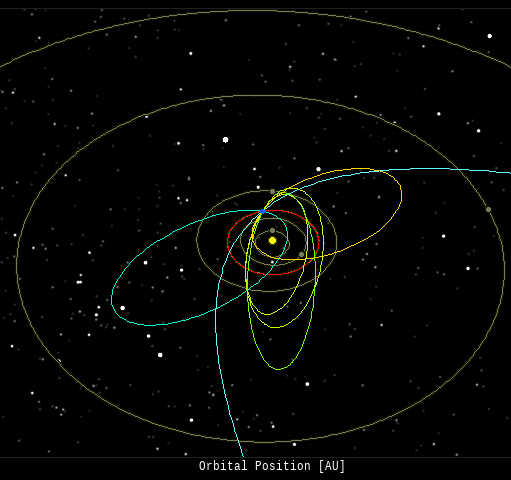
In this diagram of the inner solar system, all of the fireball orbits intersect at a single point--Earth. The orbits are color-coded by velocity, from slow (red) to fast (blue). [Larger image] [movies]
Potentially Hazardous Asteroids (
PHAs) are space rocks larger than approximately 100m that can come closer to Earth than 0.05 AU. None of the known PHAs is on a collision course with our planet, although astronomers are finding
new ones all the time.
On January 5, 2023 there were 2324 potentially hazardous asteroids.
 |
Recent & Upcoming Earth-asteroid encounters: | Asteroid | Date(UT) | Miss Distance | Velocity (km/s) | Diameter (m) |
| 2022 YS6 | 2023-Jan-01 | 4.7 LD | 9.7 | 15 |
| 2022 YR1 | 2023-Jan-01 | 16.3 LD | 6 | 22 |
| 2022 YT3 | 2023-Jan-02 | 11.1 LD | 6.4 | 24 |
| 2022 YU3 | 2023-Jan-02 | 9.8 LD | 7.1 | 24 |
| 2022 YY6 | 2023-Jan-02 | 2.1 LD | 20.3 | 21 |
| 2022 YP5 | 2023-Jan-02 | 7.8 LD | 4.8 | 14 |
| 2021 NF | 2023-Jan-02 | 17.9 LD | 11.3 | 40 |
| 2022 YJ4 | 2023-Jan-03 | 5.3 LD | 5.6 | 15 |
| 2011 WR41 | 2023-Jan-03 | 15.8 LD | 8.9 | 34 |
| 2019 AY3 | 2023-Jan-04 | 16.8 LD | 19.7 | 62 |
| 2022 YS4 | 2023-Jan-04 | 6 LD | 6.8 | 27 |
| 2022 YL4 | 2023-Jan-05 | 5.2 LD | 2 | 11 |
| 2022 YN1 | 2023-Jan-06 | 18.3 LD | 5.5 | 53 |
| 2021 TL | 2023-Jan-09 | 14.2 LD | 8.5 | 75 |
| 2022 YD5 | 2023-Jan-12 | 8.3 LD | 10.6 | 45 |
| 2022 YZ2 | 2023-Jan-12 | 16.7 LD | 6.6 | 83 |
| 2022 YS5 | 2023-Jan-13 | 15.6 LD | 6 | 42 |
| 2014 LJ | 2023-Jan-14 | 4.8 LD | 3.5 | 7 |
| 2022 YH3 | 2023-Jan-14 | 19 LD | 16.3 | 90 |
| 2012 BV13 | 2023-Jan-16 | 12.2 LD | 6.7 | 134 |
| 2020 BP | 2023-Jan-20 | 5.2 LD | 16.9 | 26 |
| 2019 BO2 | 2023-Jan-24 | 12.1 LD | 16.2 | 21 |
| 2019 BZ4 | 2023-Jan-24 | 16.5 LD | 5.6 | 20 |
| 2020 BZ14 | 2023-Jan-26 | 8.8 LD | 6.7 | 54 |
| 2022 SO113 | 2023-Jan-29 | 10.5 LD | 3.5 | 73 |
| 2017 DU34 | 2023-Feb-02 | 13.3 LD | 11.2 | 16 |
| 367789 | 2023-Feb-03 | 4.7 LD | 9.9 | 149 |
| 2020 OO1 | 2023-Feb-04 | 4.8 LD | 7.7 | 19 |
| 2022 YO6 | 2023-Feb-06 | 12.2 LD | 13.4 | 191 |
| 2022 CX1 | 2023-Feb-09 | 17.4 LD | 13.2 | 14 |
| 2021 EP4 | 2023-Feb-13 | 19 LD | 6.1 | 5 |
| 199145 | 2023-Feb-16 | 12 LD | 24.6 | 756 |
| 2022 RG | 2023-Feb-16 | 8.2 LD | 3 | 24 |
| 2020 DG4 | 2023-Feb-17 | 1.4 LD | 6.9 | 8 |
| 2020 CX1 | 2023-Feb-19 | 17.4 LD | 7.7 | 53 |
| 37638 | 2023-Feb-21 | 17 LD | 11.1 | 495 |
| 2012 DK31 | 2023-Feb-27 | 12.6 LD | 15.5 | 148 |
| 2006 BE55 | 2023-Feb-28 | 9.4 LD | 13.3 | 148 |
| 2021 QW | 2023-Mar-03 | 13.9 LD | 12.1 | 79 |
| 2017 BM123 | 2023-Mar-03 | 12.1 LD | 7.8 | 62 |
| 2007 ED125 | 2023-Mar-03 | 11.7 LD | 13.1 | 224 |
| 2015 EG | 2023-Mar-04 | 13.9 LD | 10.6 | 27 |
Notes: LD means "Lunar Distance." 1 LD = 384,401 km, the distance between Earth and the Moon. 1 LD also equals 0.00256 AU. | | Cosmic Rays in the Atmosphere |
SPACE WEATHER BALLOON DATA: Almost once a week, Spaceweather.com and the students of Earth to Sky Calculus fly space weather balloons to the stratosphere over California. These balloons are equipped with sensors that detect secondary cosmic rays, a form of radiation from space that can penetrate all the way down to Earth's surface. Our monitoring program has been underway without interruption for 7 years, resulting in a unique dataset of in situ atmospheric measurements.
Latest results (July 2022): Atmospheric radiation is decreasing in 2022. Our latest measurements in July 2022 registered a 6-year low:
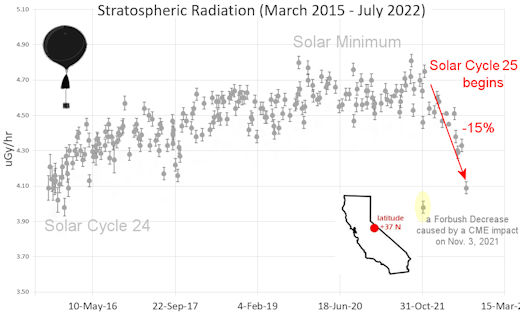
What's going on? Ironically, the radiation drop is caused by increasing solar activity. Solar Cycle 25 has roared to life faster than forecasters expected. The sun's strengthening and increasingly tangled magnetic field repels cosmic rays from deep space. In addition, solar coronal mass ejections (CMEs) sweep aside cosmic rays, causing sharp reductions called "Forbush Decreases." The two effects blend together to bring daily radiation levels down.
.Who cares? Cosmic rays are a surprisingly "down to Earth" form of space weather. They can alter the chemistry of the atmosphere, trigger lightning, and penetrate commercial airplanes. According to a study from the Harvard T.H. Chan school of public health, crews of aircraft have higher rates of cancer than the general population. The researchers listed cosmic rays, irregular sleep habits, and chemical contaminants as leading risk factors. A number of controversial studies (#1, #2, #3, #4) go even further, linking cosmic rays with cardiac arrhythmias and sudden cardiac death.
Technical notes: The radiation sensors onboard our helium balloons detect X-rays and gamma-rays in the energy range 10 keV to 20 MeV. These energies span the range of medical X-ray machines and airport security scanners.
Data points in the graph labeled "Stratospheric Radiation" correspond to the peak of the Regener-Pfotzer maximum, which lies about 67,000 feet above central California. When cosmic rays crash into Earth's atmosphere, they produce a spray of secondary particles that is most intense at the entrance to the stratosphere. Physicists Eric Regener and Georg Pfotzer discovered the maximum using balloons in the 1930s and it is what we are measuring today.
| | The official U.S. government space weather bureau |
| | The first place to look for information about sundogs, pillars, rainbows and related phenomena. |
| | Researchers call it a "Hubble for the sun." SDO is the most advanced solar observatory ever. |
| | 3D views of the sun from NASA's Solar and Terrestrial Relations Observatory |
| | Realtime and archival images of the Sun from SOHO. |
| | information about sunspots based on the latest NOAA/USAF Active Region Summary |
| | current counts of failed and deployed Starlink satellites from Jonathan's Space Page |
| | Authoritative predictions of space junk and satellite re-entries |
| | from the NOAA Space Environment Center |
| | fun to read, but should be taken with a grain of salt! Forecasts looking ahead more than a few days are often wrong. |
| | from the NOAA Space Environment Center |
| | the underlying science of space weather |
 | BestCSGOGambling is the best site for everything related to CSGO gambling on the web |
 | To find reviews of new online casino sites in the UK try The Casino DB where there are hundreds of online casino reviews complete with bonuses and ratings. Alternatively, Online-Casinos.xyz is another massive directory of online casinos listing sites for the UK and Worldwide. Casinos that offer Rupees for bonuses are very generous to Indian players. Find the best online casinos in India at AllCasinos.in Looking for a new online casino? Try Casimpo the new site dedicated to making online casino simple, or check out the new Avenger Slots Casino and Ace Online Casino with over 500 online slots and casino games. |
 | When looking for casinos to play online when the weather is bad, you can try casino online trucchi for Italian games. If you are not from Finland you can try the Swedish page Svenska casino online to find suitable games, check out svenskacasinoonline.net. Always check your local laws before playing with real money. |
 | Looking for sports betting companies not registered on GamStop? CasinoGap has presented a list of sites not on GamStop available for UK players. Check and bet online! Would you like to bet at sites not using GamStop? Look at a list of NonStopCasino sites for online betting that aren't on GamStop. Top-rated bookmakers ever! |
| | These links help Spaceweather.com stay online. Thank you to our supporters! |
| | | | | | |

